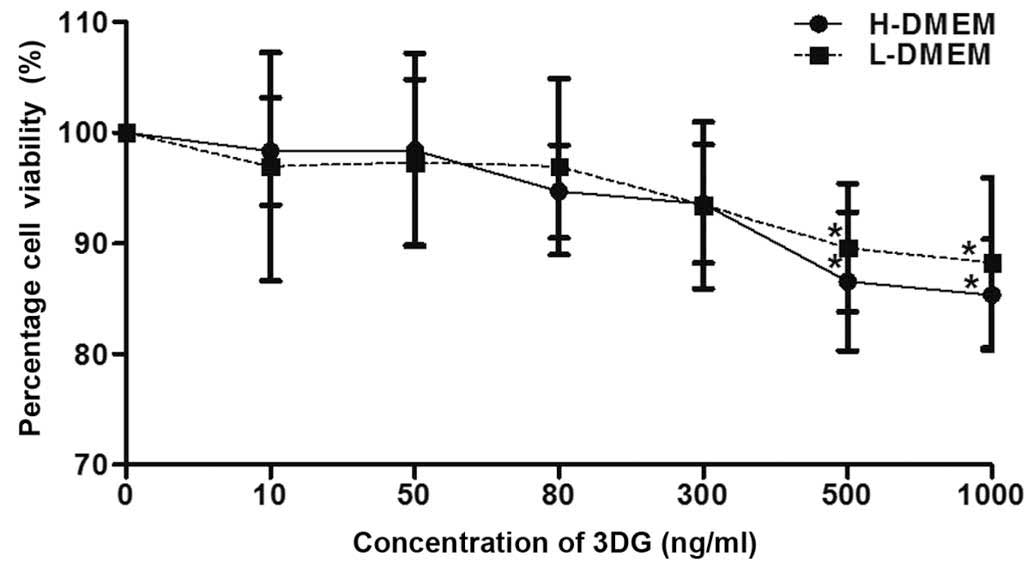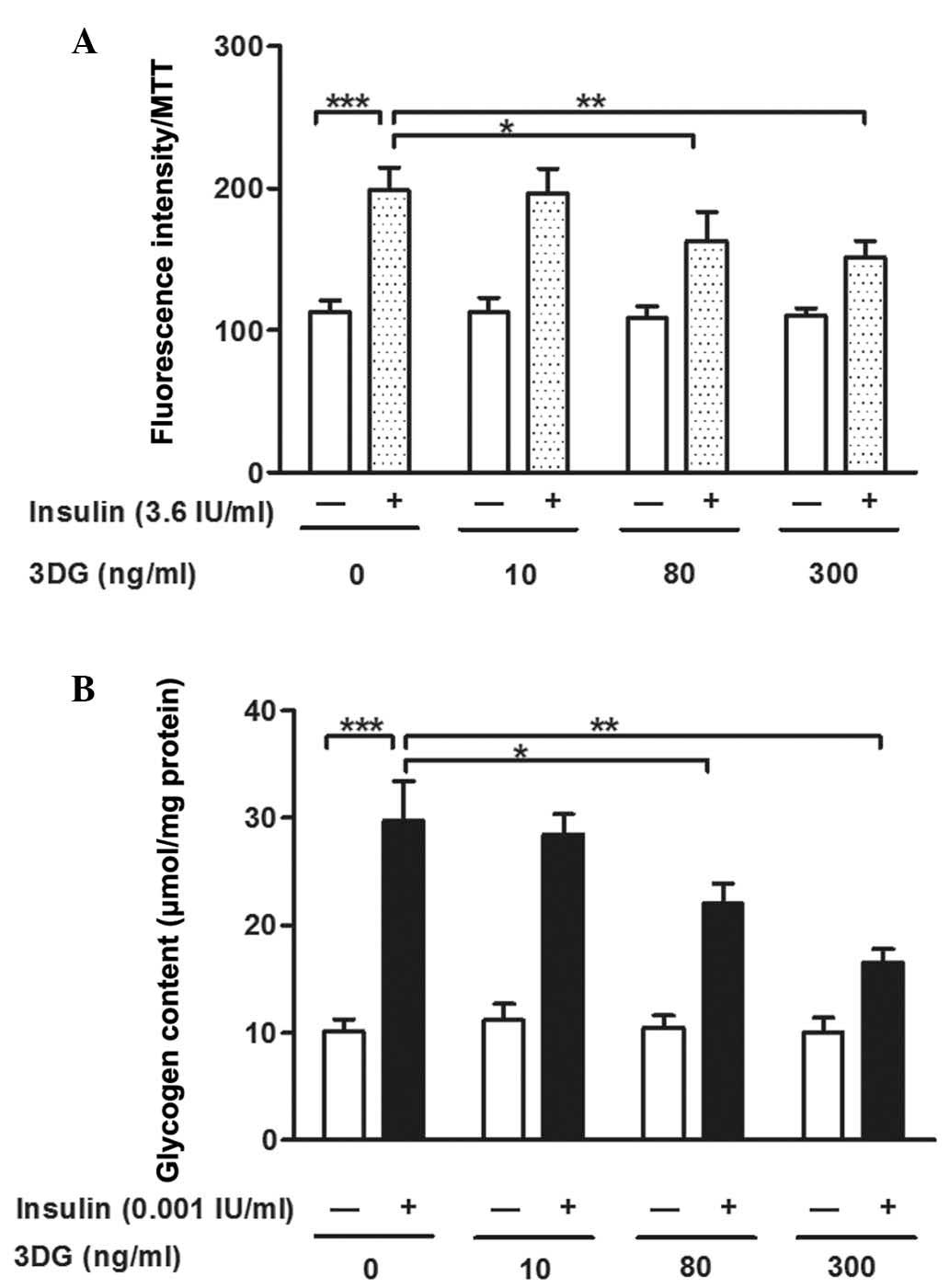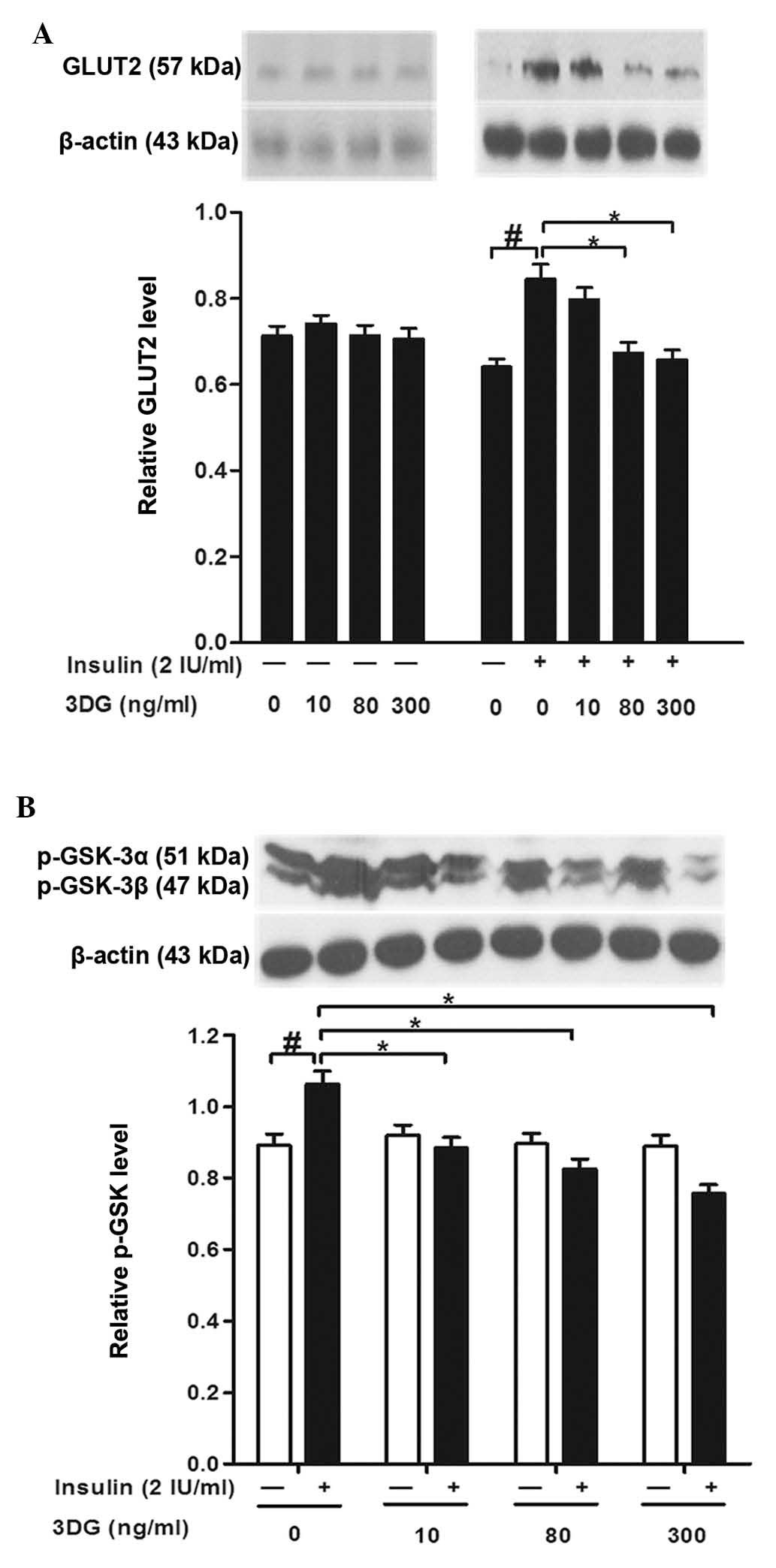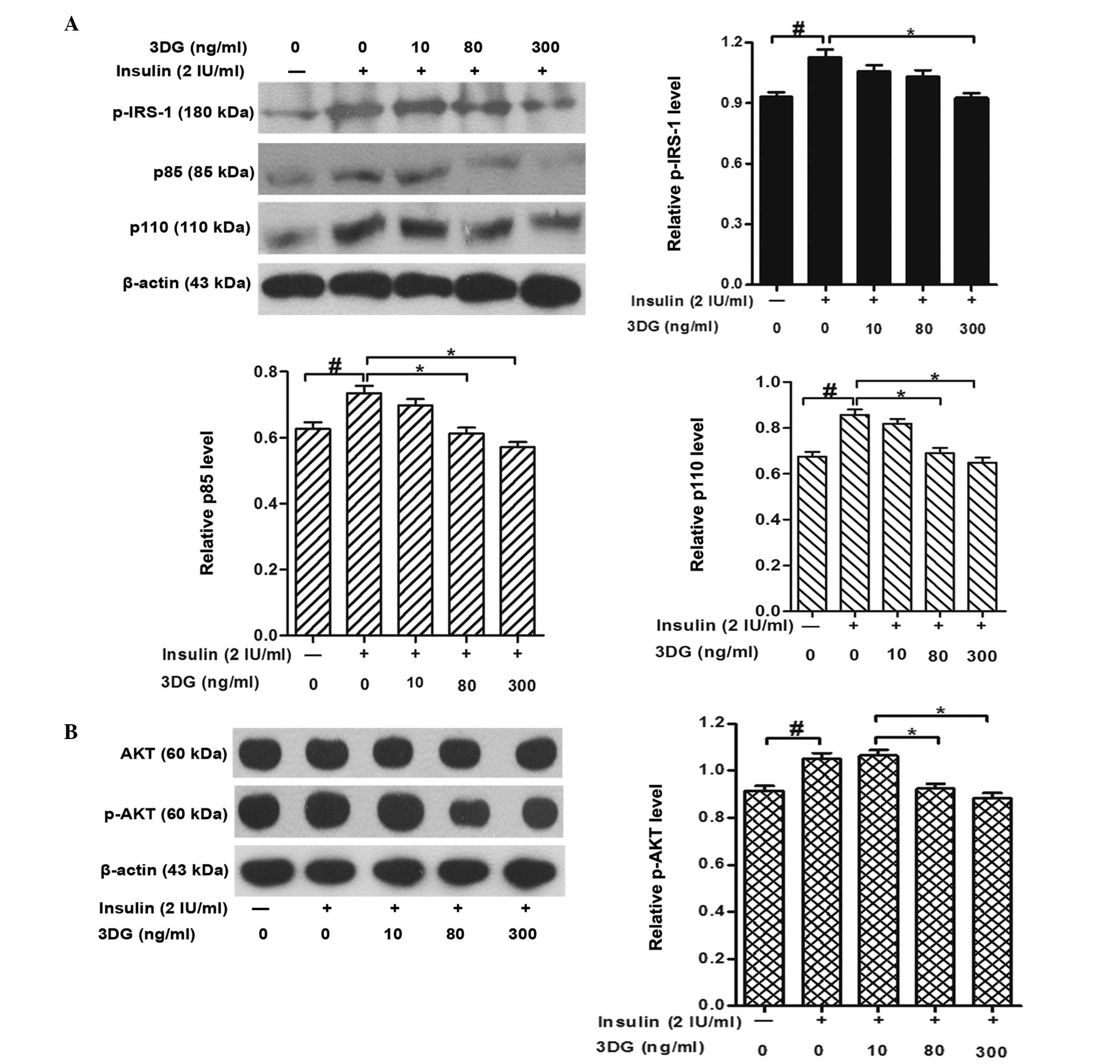|
1
|
Petersen KF and Shulman GI: New insights
into the pathogenesis of insulin resistance in humans using
magnetic resonance spectroscopy. Obesity (Silver Spring). 14(Suppl
1): S34–S40. 2006. View Article : Google Scholar
|
|
2
|
Gallagher EJ, LeRoith D and Karnieli E:
The metabolic syndrome-from insulin resistance to obesity and
diabetes. Endocrinol Metab Clin North Am. 37:559–579. 2008.
View Article : Google Scholar
|
|
3
|
Goldstein BJ: Insulin resistance as the
core defect in type 2 diabetes mellitus. Am J Cardiol. 90:3G–10G.
2002. View Article : Google Scholar : PubMed/NCBI
|
|
4
|
Taniguchi CM, Ueki K and Kahn R:
Complementary roles of IRS-1 and IRS-2 in the hepatic regulation of
metabolism. J Clin Invest. 115:718–727. 2005. View Article : Google Scholar : PubMed/NCBI
|
|
5
|
Hunter SJ and Garvey WT: Insulin action
and insulin resistance: Diseases involving defects in insulin
receptors, signal transduction and the glucose transport effector
system. Am J Med. 105:331–345. 1998. View Article : Google Scholar : PubMed/NCBI
|
|
6
|
Leclercq IA, Da Silva Morais A, Schroyen
B, Van Hul N and Geerts A: Insulin resistance in hepatocytes and
sinusoidal liver cells: Mechanisms and consequences. J Hepatol.
47:142–156. 2007. View Article : Google Scholar : PubMed/NCBI
|
|
7
|
Dou L, Zhao T, Wang L, Huang X, Jiao J,
Gao D, Zhang H, Shen T, Man Y, Wang S and Li J: miR-200s contribute
to interleukin-6 (IL-6)-induced insulin resistance in hepatocytes.
J Biol Chem. 288:22596–22606. 2013. View Article : Google Scholar : PubMed/NCBI
|
|
8
|
Sechi LA and Bartoli E: Mechanisms of
insulin resistance leading to hypertension: What we can learn from
experimental models. J Investig Med. 45:238–251. 1997.PubMed/NCBI
|
|
9
|
Shin DB, Hayase F and Kato H:
Polymerization of proteins caused by reaction with sugars and the
formation of 3-deoxyglucosone under physiological conditions. Agric
Biol Chem. 52:1451–1458. 1988. View Article : Google Scholar
|
|
10
|
Kusunoki H, Miyata S, Ohara T, Liu BF,
Uriuhara A, Kojima H, Suzuki K, Miyazaki H, Yamashita Y, Inaba K
and Kasuga M: Relation between serum 3-deoxyglucosone and
development of diabetic microangiopathy. Diabetes Care.
26:1889–1894. 2003. View Article : Google Scholar : PubMed/NCBI
|
|
11
|
Supplementto American Academy of
Dermatology 66th Annual Meeting: Inhibitors of 3-deoxyglucosone
(3DG) treat aging and inflamed skin by preventing the form action
of AGEs, oxidative stress and free radicals. San Antonio, Texas. J
Am Acad Dermatol. 2312008.
|
|
12
|
Niwa T: 3-Deoxyglucosone: Metabolism,
analysis, biological activity and clinical implication. J
Chromatogr B Biomed Sci Appl. 731:23–36. 1999. View Article : Google Scholar : PubMed/NCBI
|
|
13
|
Lal S, Kappler F, Walker M, Orchard TJ,
Beisswenger PJ, Szwergold BS and Brown TR: Quantitation of
3-deoxyglucosone levels in human plasma. Arch Biochem and Biophys.
342:254–260. 1997. View Article : Google Scholar
|
|
14
|
Hamada Y, Nakamura J, Fujisawa H, Yago H,
Nakashima E, Koh N and Hotta N: Effects of glycemic control on
plasma 3-deoxyglucosone levels in NIDDM patients. Diabetes Care.
20:1466–1469. 1997. View Article : Google Scholar : PubMed/NCBI
|
|
15
|
Beisswenger PJ, Howell SK, O'Dell RM, Wood
ME, Touchette AD and Szwergold BS: alpha-Dicarbonyls increase in
the postprandial period and reflect the degree of hyperglycemia.
Diabetes Care. 24:726–732. 2001. View Article : Google Scholar : PubMed/NCBI
|
|
16
|
Sakiyama H, Takahashi M, Yamamoto T,
Teshima T, Lee SH, Miyamoto Y, Misonou Y and Taniguchi N: The
internalization and metabolism of 3-deoxyglucosone in human
umbilical vein endothelial cells. J Biochem. 139:245–253. 2006.
View Article : Google Scholar : PubMed/NCBI
|
|
17
|
Kiho T, Asahi T, Usui S, Matsunaga T and
Ukai S: Effect of 3-deoxyglucosone on the activities of enzymes
responsible for glucose metabolism in mouse liver. Biol Pharm Bull.
19:1106–1108. 1996. View Article : Google Scholar : PubMed/NCBI
|
|
18
|
Sassi-Gaha S, Loughlin DT, Kappler F,
Schwartz ML, Su B, Tobia AM and Artlett CM: Two dicarbonyl
compounds, 3-deoxyglucosone and methylglyoxal, differentially
modulate dermal fibroblasts. Matrix Biol. 29:127–134. 2010.
View Article : Google Scholar
|
|
19
|
Dhar A, Desai KM and Wu L: Alagebrium
attenuates acute methylglyoxal-induced glucose intolerance in
Sprague-Dawley rats. Br J Pharmacol. 159:166–175. 2010. View Article : Google Scholar :
|
|
20
|
Jia X and Wu L: Accumulation of endogenous
methylglyoxal impaired insulin signaling in adipose tissue of
fructose-fed rats. Mol Cell Biochem. 306:133–139. 2007. View Article : Google Scholar : PubMed/NCBI
|
|
21
|
Dhar A, Dhar I, Jiang B, Desai KM and Wu
L: Chronic methylglyoxal infusion by minipump causes pancreatic
beta-cell dysfunction and induces type 2 diabetes in Sprague-Dawley
rats. Diabetes. 60:899–908. 2011. View Article : Google Scholar : PubMed/NCBI
|
|
22
|
Riboulet-Chavey A, Pierron A, Durand I,
Murdaca J, Giudicelli J and Van Obberghen E: Methylglyoxal impairs
the insulin signaling pathways independently of the formation of
intracellular reactive oxygen species. Diabetes. 55:1289–1299.
2006. View Article : Google Scholar : PubMed/NCBI
|
|
23
|
Fiory F, Lombardi A, Miele C, Giudicelli
J, Beguinot F and Van Obberghen E: Methylglyoxal impairs insulin
signalling and insulin action on glucose-induced insulin secretion
in the pancreatic beta cell line INS-1E. Diabetologia.
54:2941–2952. 2011. View Article : Google Scholar : PubMed/NCBI
|
|
24
|
Wang Q, Jiang Gr and Zhang Lr: Effects of
3-deoxyglucosone on blood glucose of normal mice. Chin J Diabetes.
18:220–222. 2010.
|
|
25
|
Jiang G, Zhang L, Ji Q, Wang F, Xu H,
Huang F and Wang C: Accumulation of plasma 3-deoxyglucosone
impaired glucose regulation in Chinese seniors: Implication for
senile diabetes? Diabetes Metab Syndr. 6:140–145. 2012. View Article : Google Scholar : PubMed/NCBI
|
|
26
|
Kato H, van Chuyen N, Shinoda T, Sekiya F
and Hayase F: Metabolism of 3-deoxyglucosone, an intermediate
compound in the Maillard reaction, administered orally or
intravenously to rats. Biochim Biophys Acta. 1035:71–76. 1990.
View Article : Google Scholar : PubMed/NCBI
|
|
27
|
Jiang GL, Zhang LV, Wang F, Xu H and Fei
D: Synthesis and structure analysis of the 3-deoxyglucosone (3-DG).
J Soochow Univ. 27:60–68. 2011.
|
|
28
|
Zhang L, Jiang G, Yao F, He Y, Liang G,
Zhang Y, Hu B, Wu Y, Li Y and Liu H: Growth inhibition and
apoptosis induced by osthole, a natural coumarin, in hepatocellular
carcinoma. PLoS One. 7:e378652012. View Article : Google Scholar : PubMed/NCBI
|
|
29
|
Engelbrecht B, Mattern Y, Scheibler S,
Tschoepe D, Gawlowski T and Stratmann B: Methylglyoxal impairs
GLUT4 trafficking and leads to increased glucose uptake in L6
myoblasts. Horm Metab Res. 46:77–84. 2014.
|
|
30
|
Cordero-Herrera I, Martín MÁ, Goya L and
Ramos S: Cocoa flavonoids attenuate high glucose-induced insulin
signalling blockade and modulate glucose uptake and production in
human HepG2 cells. Food Chem Toxicol. 64:10–19. 2014. View Article : Google Scholar
|
|
31
|
Schinner S, Scherbaum WA, Bornstein SR and
Barthel A: Molecular mechanisms of insulin resistance. Diabetic
Med. 22:674–682. 2005. View Article : Google Scholar : PubMed/NCBI
|
|
32
|
Mueckler M and Thorens B: The SLC2 (GLUT)
family of membrane transporters. Mol Aspects Med. 34:121–138. 2013.
View Article : Google Scholar : PubMed/NCBI
|
|
33
|
Hosokawa M and Thorens B: Glucose release
from GLUT2-null hepatocytes: Characterization of a major and a
minor pathway. Am J Physiol Endocrinol Metab. 282:E794–E801. 2002.
View Article : Google Scholar : PubMed/NCBI
|
|
34
|
Levitsky LL, Zheng Q, Mink K and Rhoads
DB: GLUT-1 and GLUT-2 mRNA, protein, and glucose transporter
activity in cultured fetal and adult hepatocytes. Am J Physiol.
267:E88–E94. 1994.PubMed/NCBI
|
|
35
|
Martinez A, Castro A, Dorronsoro I and
Alonso M: Glycogen synthase kinase 3 (GSK-3) inhibitors as new
promising drugs for diabetes, neurodegeneration, cancer and
inflammation. Med Res Rev. 22:373–384. 2002. View Article : Google Scholar : PubMed/NCBI
|
|
36
|
Medina M and Castro A: Glycogen synthase
kinase-3 (GSK-3) inhibitors reach the clinic. Curr Opin Drug Discov
Devel. 11:533–543. 2008.PubMed/NCBI
|
|
37
|
Ban KC, Singh H, Krishnan R and Seow HF:
GSK-3beta phosphorylation and alteration of beta-catenin in
hepatocellular carcinoma. Cancer Lett. 199:201–208. 2003.
View Article : Google Scholar : PubMed/NCBI
|
|
38
|
Ibrahim SH, Akazawa Y, Cazanave SC, Bronk
SF, Elmi NA, Werneburg NW, Billadeau DD and Gores GJ: Glycogen
synthase kinase-3 (GSK-3) inhibition attenuates hepatocyte
lipoapoptosis. J Hepatol. 54:765–772. 2011. View Article : Google Scholar :
|
|
39
|
Nachar A, Vallerand D, Musallam L, Lavoie
L, Badawi A, Arnason J and Haddad PS: The action of antidiabetic
plants of the canadian james bay cree traditional pharmacopeia on
key enzymes of hepatic glucose homeostasis. Evid Based Complement
Alternat Med. 2013:1898192013. View Article : Google Scholar : PubMed/NCBI
|
|
40
|
Xu YY, Wu TT, Zhou SH, Bao YY, Wang QW,
Fan J and Huang YP: Apigenin suppresses GLUT-1 and p-AKT expression
to enhance the chemosensitivity to cisplatin of laryngeal carcinoma
Hep-2 cells: An in vitro study. Int J Clin Exp Pathol. 7:3938–3947.
2014.PubMed/NCBI
|
|
41
|
Okado A, Kawasaki Y, Hasuike Y, Takahashi
M, Teshima T, Fujii J and Taniguchi N: Induction of apoptotic cell
death by methylglyoxal and 3-deoxyglucosone in macrophage-derived
cell lines. Biochem Biophys Res Commun. 225:219–224. 1996.
View Article : Google Scholar : PubMed/NCBI
|
|
42
|
Song Z, Wang H, Zhu L, Han M, Gao Y, Du Y
and Wen Y: Curcumin improves high glucose-induced INS-1 cell
insulin resistance via activation of insulin signaling. Food
Function. 6:461–469. 2015. View Article : Google Scholar
|
|
43
|
Ruan CT, Lam SH, Chi TC, Lee SS and Su MJ:
Borapetoside C from Tinospora crispa improves insulin sensitivity
in diabetic mice. Phytomedicine. 19:719–724. 2012. View Article : Google Scholar : PubMed/NCBI
|
|
44
|
Manna P and Jain SK: Decreased hepatic
phosphatidylinositol-3,4,5-triphosphate (PIP3) levels and impaired
glucose homeostasis in type 1 and type 2 diabetic rats. Cell
Physiol Biochem. 30:1363–1370. 2012. View Article : Google Scholar : PubMed/NCBI
|
|
45
|
Wang ZB, Zeng HC, Wei HS, Yi GH, Yu J,
Wang YT, Zhang YL and Yin WD: NO-1886 ameliorates glycogen
metabolism in insulin-resistant HepG2 cells by GSK-3β signalling. J
Pharm Pharmacol. 64:293–301. 2012. View Article : Google Scholar : PubMed/NCBI
|
|
46
|
Lavoie L, Band CJ, Kong M, Bergeron JJ and
Posner BI: Regulation of glycogen synthase in rat hepatocytes.
Evidence for multiple signaling pathways. J Biol Chem.
274:28279–28285. 1999. View Article : Google Scholar : PubMed/NCBI
|
|
47
|
Saltiel AR and Kahn CR: Insulin signalling
and the regulation of glucose and lipid metabolism. Nature.
414:799–806. 2001. View Article : Google Scholar : PubMed/NCBI
|
|
48
|
Kroh LW: Caramelisation in food and
beverages. Food Chem. 51:373–379. 1994. View Article : Google Scholar
|
|
49
|
Hellwig M, Degen J and Henle T:
3-deoxygalactosone, a 'new' 1,2-dicarbonyl compound in milk
products. J Agric Food Chem. 58:10752–10760. 2010. View Article : Google Scholar : PubMed/NCBI
|
|
50
|
Degen J, Hellwig M and Henle T:
1,2-dicarbonyl compounds in commonly consumed foods. J Agric Food
Chem. 60:7071–7079. 2012. View Article : Google Scholar : PubMed/NCBI
|
|
51
|
Brown TR, Su B, Brown KA, Schwartz MA,
Tobia AM and Kappler F: Modulation of in vivo 3-deoxyglucosone
levels. Biochem Soc Trans. 31:1433–1437. 2003. View Article : Google Scholar : PubMed/NCBI
|
|
52
|
Lal S, Szwergold BS, Taylor AH, Randall
WC, Kappler F, Wells-Knecht K, Baynes JW and Brown TR: Metabolism
of fructose-3-phosphate in the diabetic rat lens. Arch Biochem
Biophys. 318:191–199. 1995. View Article : Google Scholar : PubMed/NCBI
|


















